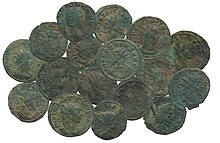
The Hoxne Hoard is the largest hoard of late Roman silver and gold discovered in Britain, and the largest collection of gold and silver coins of the fourth and fifth centuries found anywhere within the Roman Empire. It was found by Eric Lawes, a metal detectorist in the village of Hoxne in Suffolk, England in 1992. The hoard consists of 14,865 Roman gold, silver, and bronze coins and approximately 200 items of silver tableware and gold jewellery. The objects are now in the British Museum in London, where the most important pieces and a selection of the rest are on permanent display. In 1993, the Treasure Valuation Committee valued the hoard at £1.75 million.
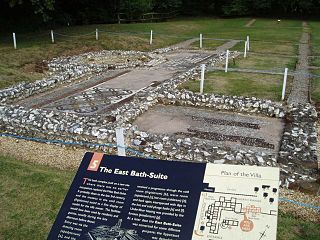
Rockbourne Roman Villa is a Roman courtyard villa excavated and put on public display in the village of Rockbourne in the English county of Hampshire. The villa was discovered in 1942 by a local farmer and excavated by A. T. Morley Hewitt over the next thirty years.

The Museum of Somerset is located in the 12th-century great hall of Taunton Castle, in Taunton in the county of Somerset, England. The museum is run by South West Heritage Trust, an independent charity, and includes objects initially collected by the Somerset Archaeological and Natural History Society who own the castle.
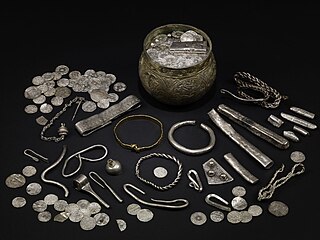
The Vale of York Hoard, also known as the Harrogate Hoard and the Vale of York Viking Hoard, is a 10th-century Viking hoard of 617 silver coins and 65 other items. It was found undisturbed in 2007 near the town of Harrogate in North Yorkshire, England. The hoard was the largest Viking one discovered in Britain since 1840, when the Cuerdale hoard was found in Lancashire, though the Anglo-Saxon Staffordshire Hoard, found in 2009, is larger.

The Milton Keynes Hoard is a hoard of Bronze Age gold found in September 2000 in a field at Monkston Park in Milton Keynes, England. The hoard consisted of two torcs, three bracelets, and a fragment of bronze rod contained in a pottery vessel. The inclusion of pottery in the find enabled it to be dated to around 1150–800 BC.
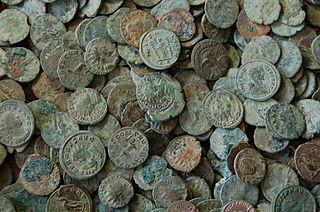
The Frome Hoard is a hoard of 52,503 Roman coins found in April 2010 by metal detectorist Dave Crisp near Frome in Somerset, England. The coins were contained in a ceramic pot 45 cm (18 in) in diameter, and date from AD 253 to 305. Most of the coins are made from debased silver or bronze. The hoard is one of the largest ever found in Britain, and is also important as it contains the largest group ever found of coins issued during the reign of Carausius, who ruled Britain independently from 286 to 293 and was the first Roman Emperor to strike coins in Britain. The Museum of Somerset in Taunton, using a grant from the National Heritage Memorial Fund (NHMF), acquired the hoard in 2011 for a value of £320,250.
The Stanchester Hoard is a hoard of 1,166 Roman coins dating from the fourth to early fifth century found in 2000 at Wilcot, in the Vale of Pewsey, Wiltshire, England. The find was considered important because of the large quantity of unclipped silver coins contained within. It was also the latest dated example of Roman coins found in Wiltshire.

The Shapwick Hoard is a hoard of 9,262 Roman coins found at Shapwick, Somerset, England in September 1998. The coins dated from as early as 31–30 BC up until 224 AD. The hoard also notably contained two rare coins which had not been discovered in Britain before, and the largest number of silver denarii ever found in Britain.

The Shrewsbury Hoard is a hoard of 9,315 bronze Roman coins discovered by a metal detectorist in a field near Shrewsbury, Shropshire in August 2009. The coins were found in a large pottery storage jar that was buried in about AD 335.

The West Bagborough Hoard is a hoard of 670 Roman coins and 72 pieces of hacksilver found in October 2001 by metal detectorist James Hawkesworth near West Bagborough in Somerset, England.
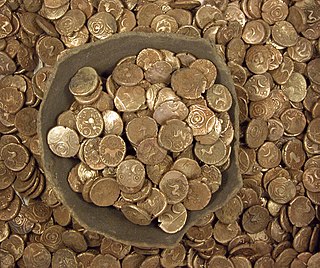
The Wickham Market Hoard is a hoard of 840 Iron Age gold staters found in a field at Dallinghoo near Wickham Market, Suffolk, England in March 2008 by car mechanic, Michael Dark using a metal detector. After excavation of the site, a total of 825 coins were found, and by the time the hoard was declared treasure trove, 840 coins had been discovered. The coins date from 40 BC to 15 AD.

The Beau Street Hoard, found in Bath, Somerset, is the fifth-largest hoard ever found in Britain and the largest ever discovered in a British Roman town. It consists of an estimated 17,500 silver Roman coins dating from between 32 BC and 274 AD. The hoard was found on Beau Street about 150 metres (490 ft) from the town's Roman Baths, built when Bath was a Roman colony known as Aquae Sulis.

The Grouville Hoard is a hoard of an estimated 70,000 late Iron Age and Roman coins reported in June 2012. They were discovered by metal detectorists Reg Mead and Richard Miles in a field at an undisclosed location in the parish of Grouville on the east side of Jersey in the Channel Islands. It is the largest hoard ever found in Jersey, and the first major archaeological find made by metal detectorists in the island.
The Lenborough Hoard is a hoard of more than 5,000 late Anglo-Saxon silver coins, dating to the eleventh century, that was found at Lenborough in Buckinghamshire, England in 2014. It is believed to be one of the largest hoards of Anglo-Saxon coins ever found in Britain.

The Overton Hoard is a Roman coin hoard dating from the early 3rd century AD. It contains 37 coins and fragments of a pottery container. It was acquired by the Yorkshire Museum in 2018.
The Leominster hoard is a hoard of coins and jewellery dating to the Viking period found near Leominster, Herefordshire in June 2015.

The Piddletrenthide Hoard is a Roman coin hoard dating from the 3rd century AD, found near Piddletrenthide, Dorset. It consisted of 2,114 base silver radiates found in a pottery vessel. The coins date to between 253 and 296 AD.
